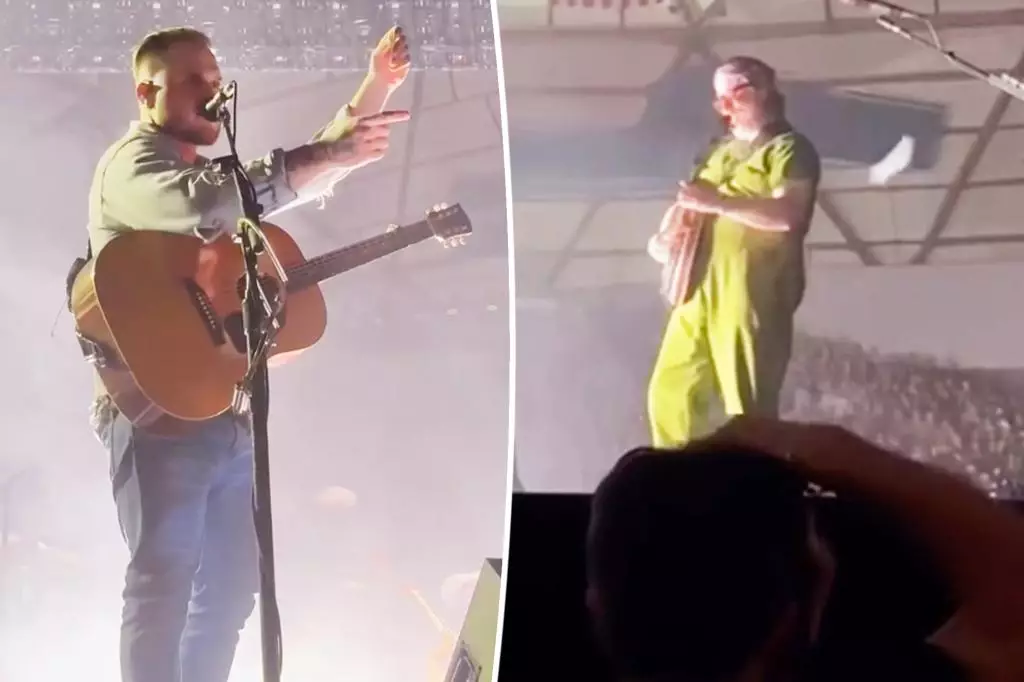In the realm of live performances, artists share a rare connection with their audiences, pouring their hearts into every note and lyric. Unfortunately, this intimate relationship can be marred by reckless behavior, exemplified recently by an incident during Zach Bryan’s concert at the Tacoma Dome. The event shed light on a disturbing trend of fans throwing objects on stage, prompting a much-needed dialogue about concert etiquette and artist safety.
During his performance, Bryan was interrupted when an object struck his guitarist, leading the singer to pause his show and confront the crowd. It was a moment of shock that prompted audiences to rationalize such behavior. Much could be speculated about why someone would throw an item during a concert—perhaps it was intended as a joke, a desperate attempt for attention, or an expression of excitement gone wrong. Regardless of intent, the reality remains that this sort of action is both disruptive and dangerous.
Zach Bryan, known for his heartfelt ballads such as “Something in the Orange,” reacted firmly, stating, “Don’t throw s–t at concerts!” His message was clear: when art and performances are disrespected, it diminishes the experience for everyone involved, including other fans who are there to enjoy the music in peace.
Bryan’s strong reaction was not just a personal defense; it spoke to a broader context of artist safety. As Bryan challenged the crowd to identify the culprit, he highlighted a pertinent issue facing performers today—crowd control. The risk of injury not only threatens the artist but also creates an uncomfortable atmosphere for the audience. Artists like Pink, Drake, and Bebe Rexha have also faced similar incidents, with varying levels of repercussions. The physical and emotional toll on performers can affect their mental health and creativity, limiting their capacity to connect with their fans in the way they intend.
Within today’s concert-going culture, we find a mixture of excitement and disarray, where the boundary between fan enthusiasm and personal space is increasingly blurred. As we witness more celebrities grappling with reckless audience behavior, a pressing question arises: how can we cultivate a respectful and safe environment at live events?
The recent incident with Zach Bryan not only serves as a cautionary tale but as a call to action for fans everywhere. Concerts should be spaces of joy and shared experience, not grounds for chaos. It’s essential for fans to recognize that their actions have consequences—every item thrown has the potential to disrupt the emotions, creativity, and safety of everyone involved.
Moreover, social media plays a dual role in this narrative, acting as both a platform for artists to engage with their fans and a space where inappropriate behavior can be documented and scrutinized. Instances like Bryan’s generate viral content but also prompt a conversation that extends beyond the concert hall. Promoters and venues need to step up their measures to ensure safety—implementing stricter policies to discourage throwing objects, and artists must be able to rely on security personnel to handle confrontations effectively.
Interestingly, the timing of this incident coincided with personal upheavals in Bryan’s life, namely his public breakup with Brianna “Chickenfry” LaPaglia. As he grapples with his own emotional challenges, one can only imagine how external disruptions, like the one at his concert, add to his stress. LaPaglia’s claims of emotional abuse and mental struggle also serve as a reminder that even celebrities carry emotional burdens. Such issues often remain under the surface but can explode amid the pressures of public life and performance.
Furthermore, when incidents like this unfold, they can overshadow the artistry and hard work of musicians. It’s critical for fans to remember that while they may view artists as larger-than-life figures, they are also individuals deserving of respect and safety.
The concert industry must evolve alongside these concerning trends. While audience engagement is vital for the live music experience, it should never come at the cost of safety or respect. The incident at Zach Bryan’s concert opened a dialogue that is crucial for the future of live performances. By promoting awareness and encouraging responsible fandom, we can foster concert environments that celebrate art and maintain safety, ensuring that both artists and fans can share unforgettable moments in harmony.

